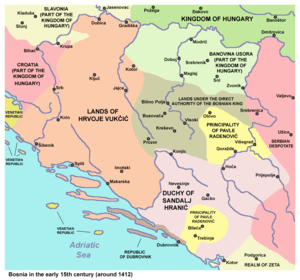Usora (province)


Usora (Latin: Vozora, Hungarian: Ózora) was a semi-independent banate (Duchy) in medieval Bosnia and also an administrative division in Croatia in the union with Hungary. It took its name from the river Usora.
The region of Usora was first mentioned in a bull (decree) by King Bela IV of Hungary dated 20 July 1244, in which he assigned some properties to the Bishop of Bosnia, naming the territories: quod episeopus (Bosnensis) et capitulum decimas in Vozora, in Sou, in Olfeld et in aliis supis ... habeant et percipiant (Vozora meaning Usora, Sou meaning Soli, and Olfeld meaning Donji Kraji).[1][2]
Its territory stretched roughly from the area of Kulaši and Prnjavor to its west, to Srebrenik and Lukavac to its east, the river Sava to its north and Žepče to its south. The Banate of Usora had many strong fortresses and cities on its territory, the most famous ones being Doboj (12th/13th century), Srebrenik (1333), Dobor (1387), Glaz (12th century), Soko (14th century), Tešanj (14th century), Modrić (14th century), and Maglaj (15th century). Also, due to its geographical location (Pannonian plateau) as the northernmost Bosnian land and its richness, Usora was, more often than not, a most common battleground between the Bosnian kingdom and the Kingdom of Hungary. The most famous battles include Battle of Srebrenik (1363), Battle of Dobor (1394 and 1408), and the Battle of Doboj (1415). Several times this duchy/banate had been separated from the rest of the Bosnian Kingdom (and attached to Hungary, banate of Slavonia) temporarily, only to be reunited once again.
Bans
- 1210-1230s: Sibislav, likely ban of Soli, supporting Hungary in its crusade against Bosnian heretics (members of Bosnian Church)
- 1230s–1250s: Matej Ninoslav, also ban of Soli, waged defensive war against Hungary
- 1272–1273: Henry I Kőszegi, also ban of Soli, appointed by the king of Hungary
- 1273: Ernye Ákos, also ban of Soli, appointed by the king of Hungary
- 1284-1316: Stefan Dragutin, also king of Syrmia, appointed by the king of Hungary
- 1316-1323: Vladislav, also king of Syrmia, son of the preceding
- 1323: Stefan Dečanski, also king of Serbia, conqueror
- 1324-1353: Stjepan, also ban of Bosnia, grandson of Vladislav
- 1353-1377: Tvrtko, also ban of Bosnia, nephew of Stjepan, jointly with Vuk
- 1400-1420s: Vukmir Zlatonosovic, also ban of Soli, supporter of Bosnian royal Kotromanic family.
From 1377, when Tvrtko I had himself crowned King of Bosnia, Usora was part of the Bosnian realm and included in the titles of Bosnian monarchs.
References
- ↑ Vjekoslav Klaić (March 1880). "Topografske sitnice (I)". Journal of the Zagreb Archaeological Museum (in Croatian). Archaeological Museum, Zagreb. 2 (1): 68. ISSN 0350-7165. Retrieved 2012-09-02.
- ↑ Pavo Živković, Marija Brandić (May 2007). "Usora i Soli u prva dva stoljeća turske prevlasti". Povijesni zbornik: godišnjak za kulturu i povijesno nasljeđe (in Croatian). Faculty of Philosophy, University of Osijek. 1 (1–2): 58&ndash, 59. ISSN 1846-3819. Retrieved 2012-09-02.
Literature
- Fine, John Van Antwerp Jr. (1994). The Late Medieval Balkans: A Critical Survey from the Late Twelfth Century to the Ottoman Conquest. The University of Michigan Press.
